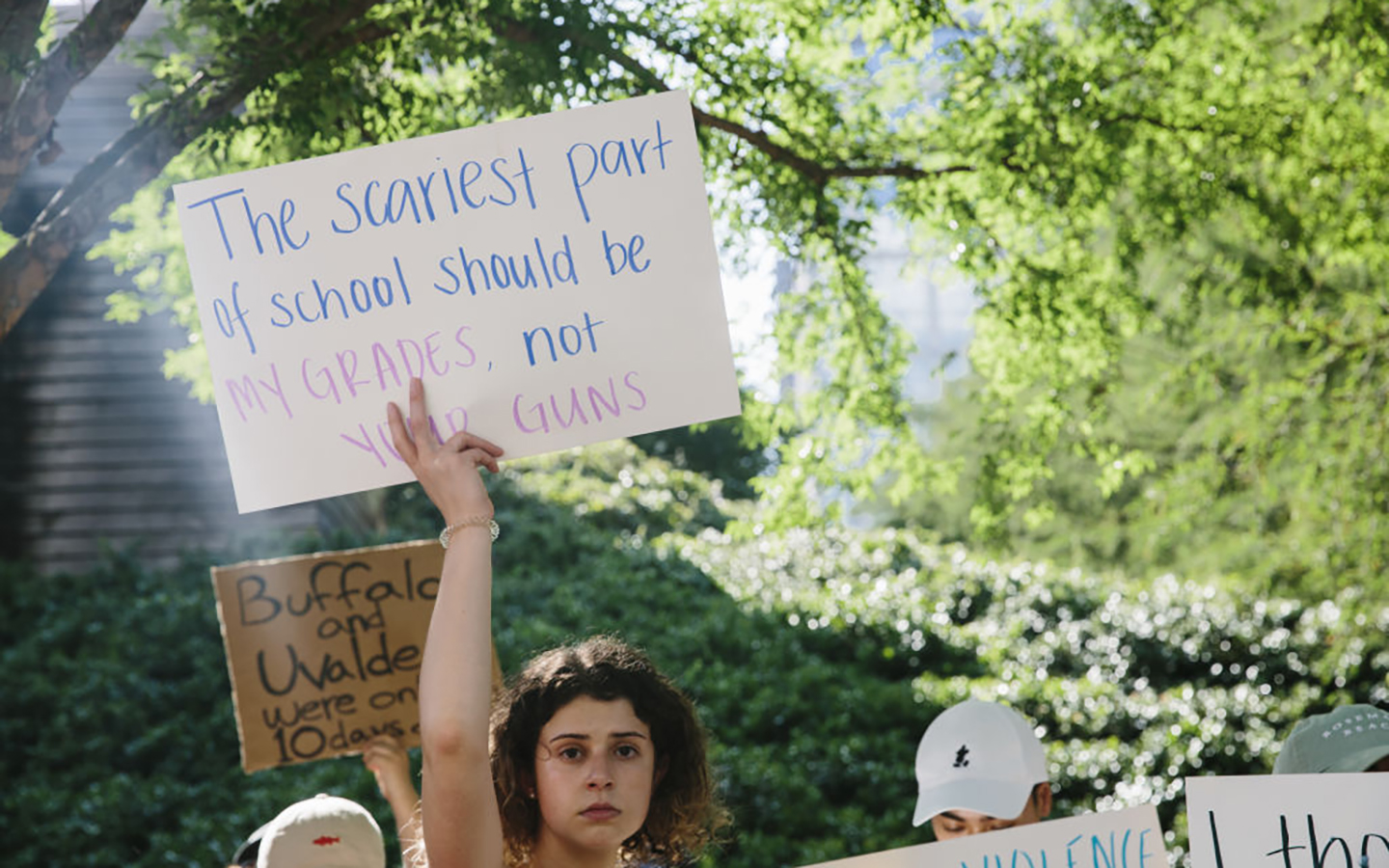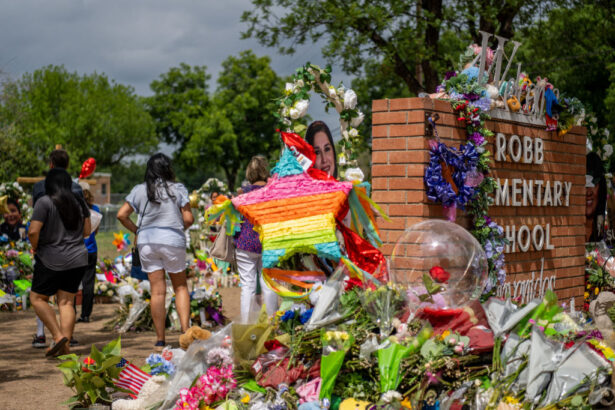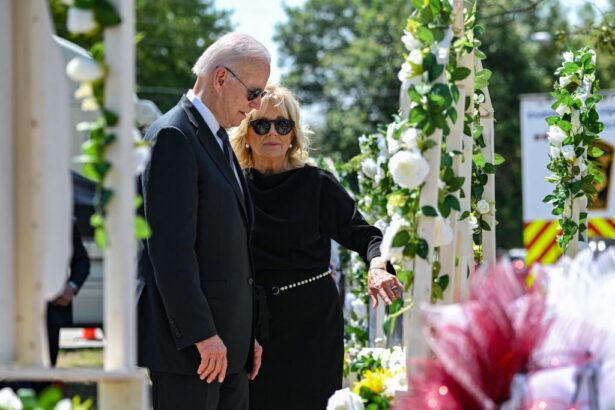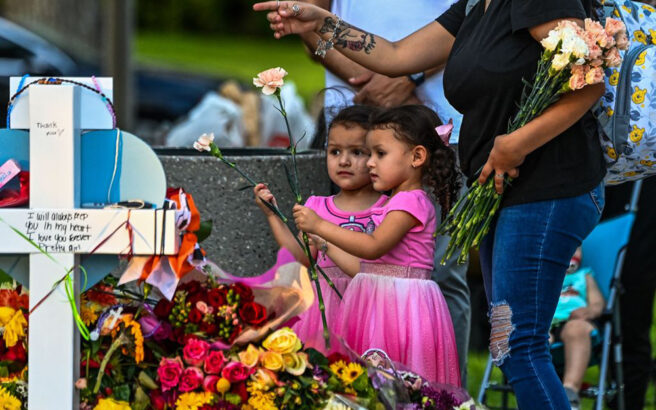‘It Doesn’t Feel Safe Going to School’: Students Reflect After Texas Shooting
In the wake of the Uvalde shooting, students across the country reported increased worries over school safety, making it difficult to learn

Walking through the schoolhouse doors suddenly felt somber and threatening for many students nationwide in the days following the May 24 shooting in Uvalde, Texas, which claimed the lives of two teachers and 19 students at Robb Elementary.
“It doesn’t feel safe going to school,” said Joshua Oh, a rising ninth grader from Gambrills, Maryland.
“Even if you … don’t go to the school where the shooting happened, it’s still something that’s in the back of your head,” said Mahbuba Sumiya, who grew up in Detroit and is now a sophomore at Harvard University.
On Monday evening, The 74 convened members of its Student Council to speak about the ripple effects of the tragic event on their own school communities and to share their thoughts on the issue of gun safety more broadly. Several young people relayed anecdotes illustrating that fear and worry spurred by the shooting reverberate far beyond Texas.
Ameera Eshtewi attends an Islamic private high school in Portland, Oregon. In May alone, there have been multiple Islamophobic attacks on mosques in her community, she said. Those events plus the Texas shooting made it hard for her not to imagine the worst at her school.
“Thinking that someone could go into an elementary school and murder so many kids and then they could hear about our school, and on top of that we’re Muslim … they could easily come in and do the same,” she said. “I felt terrified.”
At Devin Walton’s high school in South Torrance, California, the ninth grader began to anxiously take account of safety measures in a way he never had before. He noticed the location of school security officers, surveillance cameras, the locks on the door. He began to imagine how, if an intruder were to enter his classroom, he could use the fire extinguisher hanging on the wall as a possible weapon to defend himself.
“After hearing about this school shooting, I’ve started to consider to myself, like, ‘Am I safe enough at my school?’” he said.

For Maxwell Surprenant, a high school senior in Needham, Massachusetts, an otherwise innocuous task became clouded by worry. The day after the shooting, he was helping carry supplies outside for a pre-graduation ceremony. Having read the news that the Uvalde shooter entered through a side door propped open by a teacher, he couldn’t avoid a creeping thought.
“I was looking at some of the doors and wondering, all it takes is for one of these to be left open one day,” he told The 74 in a phone call separate from the group meeting.
“This shouldn’t be something that we should be concerned about,” added Sumiya, who noted that gun possession was common among her peers in high school to protect themselves from street violence, striking fear in her heart and rendering learning nearly impossible.
“We’re going to school to get the education that we need. Why is our safety and our life on the verge of, like, you never know what can happen?”
With March For Our Lives youth organizers planning a June 11 rally in Washington, D.C. to demand universal background checks, students agreed that school safety and the prevention of shootings is one of the major issues on the minds of young people today.
“It’s such an important issue to us, to this generation, particularly because this generation, Gen Z, has really experienced it,” said Diego Camacho, a high school senior in Los Angeles, California.
School shootings have increased in severity and deadliness over the past decade. Excluding 2020 when schools were largely remote, there has not been a full calendar year since 2018 — the year of the mass shooting at Florida’s Marjory Stoneman Douglas High School that galvanized the March For Our Lives movement — with fewer than 27 classroom attacks. The highest annual tally before that, spanning from 1999 to 2017, was 16 school shootings. Through only five months this year, there have already been 24.
There’s a cognitive dissonance to hearing about events that are as terrifying and heart wrenching as school shootings with such regularity and needing to continue going about their lives, expressed students. It’s weird, said Oh, that when a school shooting happens, it almost feels like a “normal event.”
“I felt a little numb,” added Eshtewi. “I was angry that I felt numb because this shouldn’t be something normal.”
The Uvalde shooting was the deadliest attack on a school since the 2012 mass shooting at Sandy Hook Elementary School in Newtown, Connecticut, which killed 20 children and six educators.
In the days after the shooting, Canadian Prime Minister Justin Trudeau announced plans to freeze handgun sales and ban military-style firearms, including a mandatory buy back program set to begin at the end of the year. Meanwhile, after visiting with survivors and families of victims in Uvalde, Texas, U.S. President Joe Biden said policy changes such as background check requirements or assault weapon bans must come from Congress, which remains gridlocked on the issue.

But while Washington stands still, students are mulling what they think should be the path forward. The Uvalde shooting, said Suprenant, spurred meaningful conversations within his friend group, which spans the full political spectrum.
The high school seniors thought about the stark difference between the requirements for gun ownership and for driving a car—both activities that can pose a deadly threat to oneself and others. To earn a driver’s license, young people must first take a permit test, complete a driver’s education course and log a specified number of training hours, the teenagers observed, but no comparable preparations are required to purchase a gun in this country.
The accused shooter, who didn’t have a driver’s license, crashed his grandparents’ car before opening fire at Robb Elementary, authorities said. A week earlier, he was able to legally purchase two AR-15-style rifles, according to authorities.
“It’s just common sense to all of us that the process should be longer in terms of obtaining a weapon,” said Surprenant.
The accused shooter crashed his grandparents’ car before opening fire at Robb Elementary, authorities said. His grandfather told ABC News that his grandson, who legally purchased two AR-15-style rifles last month, didn’t have a driver’s license.
Sumiya agreed that gun control measures are overdue, but also pointed to deeper issues like poverty and housing insecurity, which she thinks played into the high crime rates where she grew up.
“What [are] the underlying concerns making someone go out of their way and then buy a gun?” she wondered. Teachers should be raising those questions and “talking about issues like that in the classroom setting.”

Surprenant offered advice to educators looking to facilitate dialogue on gun safety: Give students access to resources through which to inform themselves, but then “encourage kids coming up with their own solutions.”
With little to show for the efforts of adult policymakers to advance gun safety measures, Eshtewi understands that young leaders may have to pick up the torch. That frustrates her, but she sees no other choice.
“With any issue I remind myself, if not us, then who?” said the high school junior.
This story was brought to you via The 74’s Student Council initiative, an effort to boost youth voices in our reporting. America’s Promise Alliance helped in the recruiting of our diverse 11-member council and the idea was conceived as part of Asher Lehrer-Small’s Poynter-Koch Media and Journalism Fellowship.
Get stories like these delivered straight to your inbox. Sign up for The 74 Newsletter

;)
